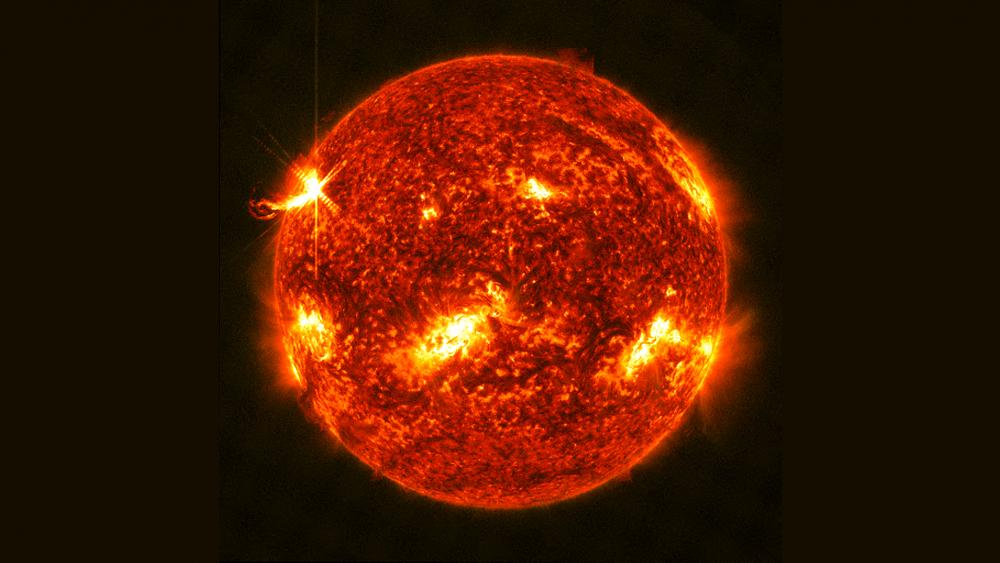According to scientists, every 11 years, the sun goes through a cycle where its magnetic poles (North and South) reverse or switch places.
The sun's poles last flipped in 2013, so the next event is on schedule to take place this year, according to Vox.com.
Scientists say there's no need to panic. It's not a sign of the apocalypse. You won't even notice it when the flip happens. But it's not the pole reversal itself that's the main cause for concern.
With the sun's surface growing more active, serious anomalies can happen. While that's great news for amateur astronomers who are set to see some amazing solar fireworks through their telescopes, it could be bad news for power grids and communication satellites circling the Earth.
There's already intense magnetic activity now happening on the sun's surface that marks a kind of lead-in that comes before the poles' reversal.
"We are indeed seeing the sun more active than it's been in probably something like 20 years," Paul Charbonneau, a solar physicist at the University of Montreal, told Vox.
It's during these peak periods of solar activity that the sun's fireworks grow larger.
"When the magnetic energy content of the sun is a lot larger, that's when you tend to get more solar flares, more {coronal} mass ejections — more fun stuff," Charbonneau said.

NASA’s Solar Dynamics Observatory captured this image of a solar flare – as seen in the bright flash on the right – on Aug. 5. 2023. The image shows a blend of extreme ultraviolet light that highlights the extremely hot material in flares which is colorized in red and orange. (Photo credit: NASA/GSFC/SDO)
It's these Coronal Mass Ejections (CME) that hurl charged matter out across the solar system like a giant shotgun, resulting in a potentially disruptive solar storm.
Grid Operators Have Been Watching
As CBN News reported in December 2021, grid operators in some regions of the country have been heeding warnings to prepare for solar storms and sunspots blasting particles into space.
William Murtagh's group at the National Oceanic and Atmospheric Administration (NOAA) maintains a direct line with all the electric companies in the event of a geomagnetic eruption.
"When we see one of these large eruptions occurring in the sun, what we call Coronal Mass Ejection, coming towards Earth, we initiate this hotline call and we make communication with essentially the entire grid, owners and operators across the nation," Murtagh, who serves as program coordinator at NOAA's Space Weather Prediction Center, told CBN News.
Researchers with the U.S. Geological Survey released a map in 2020 showing grid systems in the Midwest and Eastern Seaboard that are particularly vulnerable to solar storms.
Murtagh says electricity operators are now constantly assessing areas of vulnerability.
"If there's vulnerability in certain equipment, maybe they can modify that equipment, the manufacturing of that equipment, to make it hardened, to make it better protected against a geomagnetic storm," Murtagh said. "There are many different actions they can take to ensure that the grid stays up and running during these big geomagnetic storms."
***Please sign up for CBN Newsletters and download the CBN News app to ensure you keep receiving the latest news.***
 Most Powerful Solar Storm in 150 Years Missed the Earth in 2012
Most Powerful Solar Storm in 150 Years Missed the Earth in 2012
On July 23, 2012, an eruption on the Sun sent giant particle clouds hurtling through space at 6.7 million miles per hour, missing Earth but passing straight through a satellite in its path. Scientists say that extreme solar storm is believed to have been the most powerful in at least 150 years.
Dr. Doug Biesecker is a solar physicist with NOAA's Space Weather Prediction Center. He said what keeps him up at night about space weather is missing the forecast of the one in a 100-year surface storm on the sun.
"The sort of storm that would cause a widespread power outage. You know you could imagine maybe the entire Northeast losing power for at least a few hours if not for a day or more," Biesecker said.
The Largest Solar Storm on Record Struck Our Planet in 1859
In 1859, one of these solar eruptions hit Earth. Now known as the "Carrington Event," it's the largest geomagnetic storm on record.
The technology of the day was the telegraph, and telegraph operators were able to disconnect their batteries and use the electricity caused by the solar storm to run their systems. But it also caused fires at some telegraph stations.
That storm had such an impact on Earth that the so-called Northern Lights could be seen from the equator.
Analysts say a direct hit by an extreme CME like the one in July 2012 could be catastrophic, leading to widespread power blackouts.
READ Experts Warn Cyber Hackers, EMP Attacks and Solar Storms Could 'Annihilate Our Electric System'
A study by the National Academy of Sciences reported the total economic impact could be more than $2 trillion -- 20 times greater than the cost of Hurricane Katrina.
In today's technology-driven world, the solar superstorm could have done serious damage to homes on Earth and continued traveling up into space.
It could have disrupted spacecraft, satellite communications, GPS, airplane flights, and the power grid, which could have knocked out power to everything from businesses to houses.
"Without the electric grid, well, of course, there's no power. There's also no water; there's also no communications, no transportation, no medical care," Dr. Avi Schnurr, CEO and president of the Electric Infrastructure Security Council explained.
"The financial system would be down," he continued. "The environmental effects would be catastrophic at a level that we've never seen before."
In addition, it could take years to repair multi-ton transformers.
Comparing the 2012 solar storm to the blast from the sun in 1859, University of Colorado scientist Daniel Baker said, "The only difference is, it missed."
Opportunity to Study, Better Understand Our Star
But scientists see opportunity during this time of heightened solar activity. They want to study the sun to learn how to better predict space weather, according to Vox.
Predicting weather in space, like meteorologists do on the earth, would lead to safer space travel. NASA has targeted September 2025 for Artemis II, the first crewed Artemis mission around the Moon, and September 2026 for Artemis III, which is planned to land the first astronauts near the lunar South Pole.
Artemis IV, the first mission to the Gateway lunar space station, remains on track for 2028.
The next goal will be sending humans to Mars.
Did you know?
God is everywhere—even in the news. That’s why we view every news story through the lens of faith. We are committed to delivering quality independent Christian journalism you can trust. But it takes a lot of hard work, time, and money to do what we do. Help us continue to be a voice for truth in the media by supporting CBN News for as little as $1.











 Support CBN News
Support CBN News







